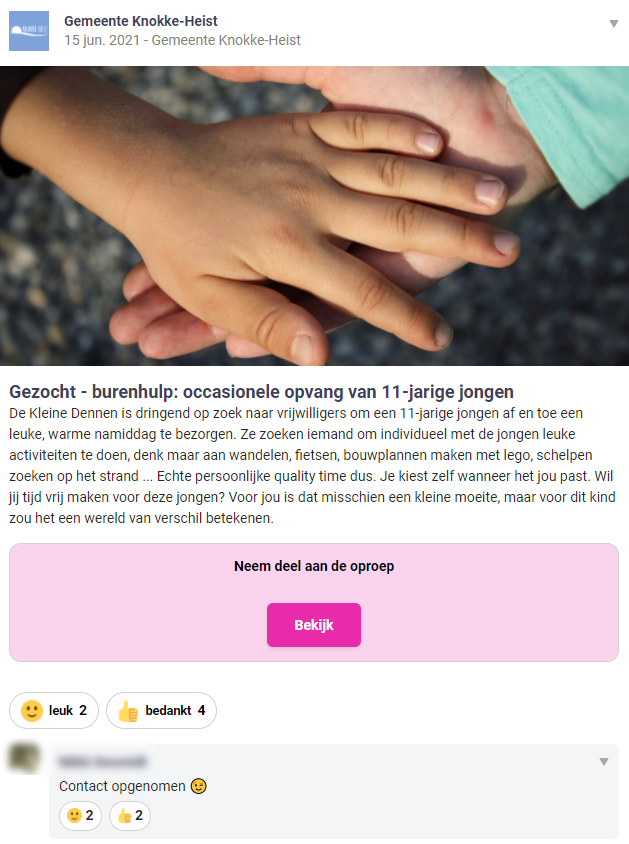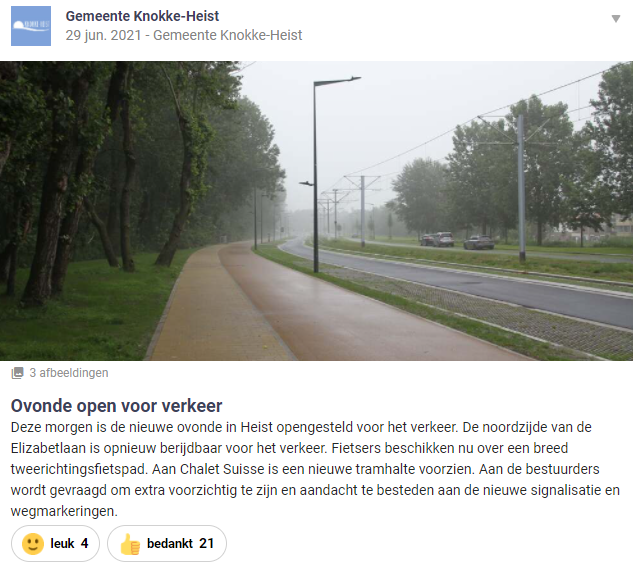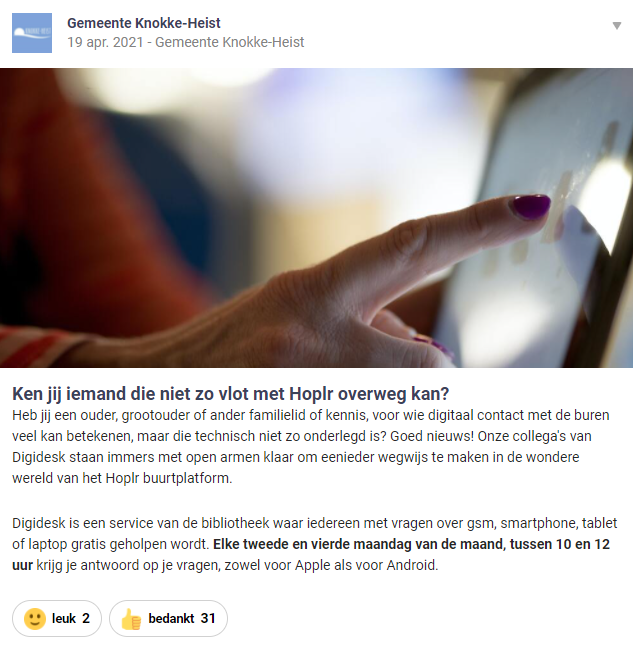Case study Municipality of Knokke-Heist: this is how services work together for varied neighbourhood communication via Hoplr (five steps)
Many different government departments deal with information that may be of value to a neighbourhood. From public health and community development to garbage collection and road works: how should departments organise their fluxes of neighbourhood communication? The municipality of Knokke-Heist let us take a look behind the scenes. In this article, the municipality shares the five steps it took to organise its communication on Hoplr:
- Set up a working group
- Define a vision
- Appoint a key person
- Inspire as many departments as possible
- Set clear boundaries
The arrival of Hoplr in Knokke-Heist Municipality
As an objective within its transversal policy, the municipality of Knokke-Heist focuses on community development more than ever. The Welfare Department is carrying out the ‘Neighbourhood care 2.0’ project. With it, Knokke-Heist aims to stimulate local social cohesion and detect vulnerabilities within the neighbourhoods.
With these objectives in mind, the municipality started a Hoplr pilot project in four neighbourhoods, back in November 2019. The municipality of Knokke-Heist viewed the digital neighbourhood network as a potentially important support tool. Not just for project Neighbourhood care 2.0, but also to inform citizens about various neighbourhood-related themes.
Under the influence of the corona crisis and a positive evaluation of the pilot project, Knokke-Heist launched Hoplr in all of its neighbourhoods sooner than expected. To support this, the administration applied an efficient, cross-departmental implementation, which can be summarised in five steps.
“When social life came to a complete standstill during the first lockdown, our own neighbourhoods became the anchors that citizens could cling onto. The need for neighbourly connections was never greater and the Hoplr proved to be the perfect channel for our neighbourhoods to connect or stay connected.”
Annelies Daniels, Communication Department of the municipality of Knokke-Heist
Step 1: Set up a working group
Right from the start, the municipality of Knokke-Heist had a vision with contributions from various municipal departments. The administration set up a working group with representation from five parties that would be most involved:
- Welfare department
- Communication department
- Culture and participation department
- ICT service
- Volunteer Centre
The working group’s motivation is twofold. On the one hand, the municipality ensures that management remains centralised and the objective clear. At the same time, the working group allows for an open structure, where varying interests and expertise reinforce one another.
- As social workers, the people in charge of the Welfare Department are perfectly apt to assess social policy, functioning and objectives in terms of neighbourhood care.
- Annelies Daniels, who is responsible for communication, watches over the language and tone of voice and publishes messages according to plan. Knokke-Heist is also a municipality with a predominantly older public. Annelies therefore brings a lot of insight to the working group to help seniors find their way to Hoplr.
- The ICT service knows how to make certain digital concepts understandable to various target groups.
- The municipal volunteer centre matches volunteers, organisations and projects. Via Hoplr, the municipality can call on volunteers from the neighbourhood, which benefits both neighbourly help and social cohesion.
Step 2: Define your vision
Once a month the working group meets either digitally or physically. The agenda of such meetings is based on current challenges, ideas and long-term goals. Defining a vision was one of the first and most important tasks the working group checked off.
The vision was of course grounded in the administration’s social ambitions. It helps determine at the outset which types of communication do or do not have a place on Hoplr. The board itself described it as follows:
- Neighbourhood-oriented communication: supporting social connections and care within communities
- Neighbourhood-oriented policy news: providing neighbourhood-oriented information
- Citizen participation: involving citizens in hyper-local policy
- Connecting communication: stimulating users towards neighbour help
- Facilitating communication: tips on how to use Hoplr
Step 3: Appoint a key person
As a social medium, Hoplr was accommodated by the Communication department. That’s why at first, Communications bore the final responsibility within the working group. However, due to the social approach, the municipality-wide roll-out led to a small reorganisation. By placing the final responsibility with the ‘Social House‘ (social department), the objective became even more sharply defined.
Communication manager Annelies Daniels, however, remains the key person in the organisation of neighbourhood communication. That’s because Annelies is the contact person and editor in regards to neighbourhood communication via Hoplr. She keeps in touch with all services, the police and even the local water company. She herself draws inspiration from the municipal newsletters. Annelies aims to share neighbourhood-related news with the Hoplr neighbourhoods before she shares anywhere else.
Step 4: Involve other departments
In March 2020, the working group organised a brainstorm with all departments. The purpose of this brainstorm was twofold. On the one hand, they wanted to put their heads together and collect ideas to make Hoplr even more successful. Even more important, however, was the opportunity to inform all services about the possibilities and value of the digital neighbourhood network.
Step 5: Set clear boundaries
Since then, several ambassadors within various services know they can share their news with the Hoplr-neighbourhoods via an e-mail, phone call or Team message to the Communication department. Neighbourhood communication has sparked a great deal of interest. But thanks to a razor-sharp vision, the working group knows exactly which messages ought to be redirected to other channels. This mainly concerns announcements of non-neighbourhood events, general news and messages with commercial value.
All members of the working group, however, have direct access to Hoplr’s Service Dashboard (SDB). This allows the Welfare, ICT, Culture and Volunteer departments to chat with Annelies through the SDB. However, the group naturally switched back to e-mail correspondence as time went by. The entire working group does however make good use of the dashboard’s ability to draft messages. These are then checked, edited and scheduled by communications manager Annelies.
Activity within the Hoplr neighbourhoods
A positive assessment of the pilot project and a growing demand due to the corona crisis led to a launch in all neighbourhoods of Knokke-Heist by April 2020. Thanks to a municipality-wide promotional campaign with banners, bread bags with the Hoplr logo, and a press article, the conversion rate climbed to 20%. Today, 15 months after the full roll-out, the municipality reaches 27% of its households through Hoplr.
Thanks to a carefully thought-out communication strategy, the working group knows exactly what kind of messages have a place on the digital neighbourhood network. In cooperation with all its services, the municipality has now posted 251 neighbourhood-oriented messages on Hoplr.



Other than that, the municipality of Knokke-Heist has already used the participation functionalities several times to survey the neighbourhoods.
- 444 respondents provided information about their mode of transport to the vaccination centre.
- 617 citizens helped decide on the new name for a multifunctional space.
- 269 Hoplr members shared their first experiences with the digital neighbourhood network. 88% said they would recommend Hoplr to acquaintances, and 66% said Hoplr had already brought them closer to their neighbourhood.
The volunteer centre has been successfully connecting citizens with helpful neighbours by publishing calls for volunteers. From the maintenance of a grave to an afternoon of board games. Besides that, the Service Dashboard gives the municipality direct access to another 69 volunteers who spontaneously registered for all kinds of neighbourly help.
“Strengthening social cohesion through an online neighbourhood platform such as Hoplr means making small help possible offline. Someone who has a request for help and dares to ask it on Hoplr, may next time be able to ask it directly to a neighbour ‘from behind the corner’ who helped out earlier. These engagements are worth their weight in gold for the neighbourhood care project.”
Lien Zutterman, Coordinator Service Welfare Knokke-Heist
Conclusion
The municipality of Knokke-Heist has inspired us with its hands-on implementation. Let’s recap its five tips.
- Put a working group together, made up of a varied but limited core of directly involved parties
- Define a vision that you can always refer back to
- Designate a key person responsible for the final communication
- Inspire as many services as possible to get the most out of Hoplr
- Set clear boundaries: who can be reached in what way and under what conditions, sticking to the vision
Neighbourhood communication is off to a great start in Knokke-Heist. But we have a feeling that the municipality has more in store. Now that the corona measures are easing off, the board is thinking about organising Hoplr neighbourhood cafes. These are events during which citizens can have a drink and connect in a Hoplr-themed setting. A ‘digital doctor’ will be present to help people set up their accounts and get started with Hoplr. We can’t wait to see what’s next!
Curious about what neighbourhood communication might look like? Read one of these articles next:





